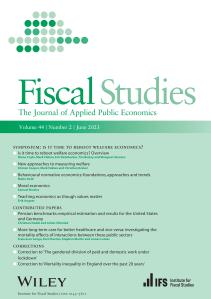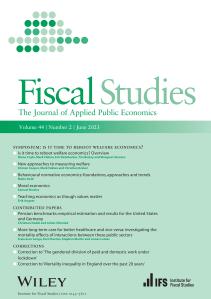Few policies introduced during the 14-year period of Conservative government are likely to have as significant a long-term impact as the introduction of universal credit (UC) – an integrated means-tested benefit that is replacing six ‘legacy’ benefits, combining out-of-work support with support for housing costs, incapacity and children. It genuinely represented the biggest single shake-up to the benefits system since Beveridge.
When fully rolled out, 29% of working-age families (8.2 million) will be entitled to UC at any one time, and most people are likely to be in a household receiving it at some point in their life. While the initial roll-out of UC was bumpy, to say the least, UC in its current form is in many ways an improvement on the previous system. It has simplified and rationalised the benefit system by replacing a patchwork of benefits with a single payment, and it played a key role in supporting households during the pandemic. But UC does not simply represent a technical change in benefit administration – it impacts millions of households’ incomes by thousands of pounds, both positively and negatively.
These are findings from a new IFS report released today, funded by the abrdn Financial Fairness Trust, which explores the impact of the UC reform on households’ incomes and work incentives. It finds that:
- When fully rolled out, around 4.5 million families with nobody in work will be entitled to UC, as well as 3.6 million working families.
- On average, UC represents a net giveaway of £2½ billion a year. But this is the combination of many winners and losers. 47% (3.7 million) of households affected by the UC reform gain at least £200 per year while 32% (2.5 million) are worse off by at least £200 per year (though some will – in the short run – avoid losses through ‘transitional protection’).
- Many face very large changes in their incomes. 25% (2.0 million) of affected households are better off under UC by at least £2,000 per year and 21% (1.6 million) are worse off by at least that much. For context, average household income among families affected by the reform is £34,000 per year.
- On average, households in the bottom 40% of the income distribution gain from the reform. Couples with children, in-work households and renters are most likely to be better off under UC than under the legacy system. ‘Mixed-age couples’ (one adult below state pension age and one above) and those with over £16,000 in assets tend to lose from the change, sometimes by substantial margins. The same is true for some households receiving health-related benefits and some with self-employed workers.
- UC has been successful in reducing the number of workers facing very high effective tax rates on working. Under the legacy system, 26% of workers lost at least 70p from withdrawn benefits or higher taxes if they earned an extra £1. By (on average) reducing the speed at which benefits are withdrawn as earnings increase, UC has reduced this figure to 9%. But the consequence of doing this is that UC now reaches more workers, which weakens their incentives to increase earnings. Indeed, for some types of families, UC extends a long way up the income distribution. For example, a couple with two children in rented accommodation can be entitled to some UC if a single earner is on up to around £70,000; and in expensive areas such as London, they could even be entitled to UC on salaries of more than £100,000.
There are also key challenges for the next government in finishing the roll-out of UC, due to take place over the next 18 months:
- There are still 1.2 million claimants of legacy benefits who need to be ‘migrated’ to UC. Such migrations offer serious challenges. Last year, of the 381,000 existing tax credit recipients who received a ‘migration notice’ telling them to claim UC, 122,000 (32%) did not do so and so saw their benefit payments stop.
- 900,000 of those left to be migrated have a disability that prevents them from working. These people are a particularly vulnerable group who may face even more acute difficulties with putting in a UC claim. While the government has promised to provide them ‘enhanced support’, there is a very real risk of a situation where large numbers of disabled claimants, often receiving over £10,000 a year in means-tested benefits, suddenly lose that financial support.
Sam Ray-Chaudhuri, a Research Economist at IFS and an author of the report, said:
‘Universal credit has transformed the landscape of means-tested benefits in the UK. In its current form, it offers some key advantages over the legacy benefits system it replaces, in particular getting rid of the very high effective tax rates on work that some workers used to see. The impact on household incomes is mixed, with large numbers of households gaining and losing significantly.
‘For the next government, the biggest challenge remaining is the migration over to UC of 1.2 million legacy benefit claimants. Evidence so far suggests large numbers of claimants have not applied for UC before their legacy benefits are stopped. As the roll-out progresses, there is a risk that large numbers of vulnerable claimants see interruptions to benefit income they very much rely upon.’
Mubin Haq, Chief Executive of abrdn Financial Fairness Trust, said:
‘There are winners and losers from the introduction of universal credit. Those on the lowest incomes have benefited, with the bottom 40% of households gaining on average. Those in work, families with children and renters have seen improvements. But the self-employed and those with health-related problems tend to lose out.
‘There’s still much to fix. Whilst there have been significant moves to rationalise work incentives and universal credit encourages people to move into part-time work, more can be done to support part-time workers into full-time work. Reducing the rate at which this benefit is reduced or increasing work allowances would make a real difference.’










